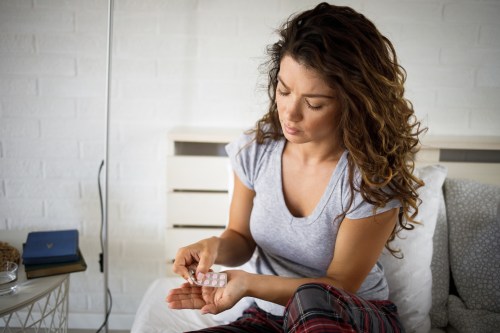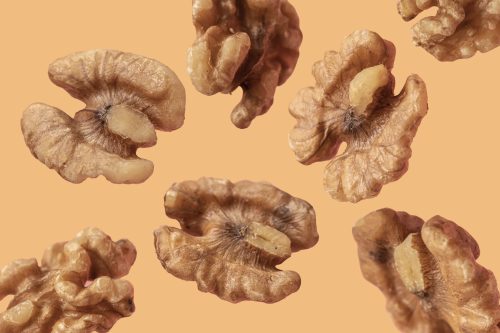This Popular Medicine Has *Nothing* to Do With Periods—but Can It Help Severe PMS Symptoms?
TikTokers say "yes." Here's what the science says.

TikTok health trends come and go, but this recent hack for a specific women's health issue has racked up millions of views on social media and doesn't seem to be going away anytime soon: taking antihistamines for premenstrual dysphoric disorder (PMDD). More specifically, people have found that taking a popular medicine known as Pepcid AC—aka famotidine, a stomach acid reducer available over-the-counter and by prescription—has helped ease some physical, mental, and emotional symptoms of PMDD, which is notoriously hard to treat.
Experts in This Article
a pharmacist, medical writer, and healthcare system expert
pharmacist and vice president of clinical operations at Rite Aid Corporation
board-certified OB/GYN at Marchand Institute for Minimally Invasive Surgery
PMDD is a mental health disorder that's essentially a severe form of premenstrual syndrome (PMS). The condition affects about 1 in 20 women of reproductive age and is characterized by drastic mental and physical health changes in the week or two leading up to menstruation. Symptoms can include anxiety, depression, irritability and mood swings, plus fatigue, head and body aches, and bloating, among many others; people have described it like being on an emotional and physical roller coaster. Traditionally, PMDD is managed with a combination of lifestyle changes and medications (such as antidepressants or hormonal birth control), though several women with the condition have noted this isn't always enough to tame symptoms.
This is when the search for alternatives happens. But why Pepcid? Well, experts are led to believe that histamine—a chemical released by the body during allergic reactions—might play a role in PMS and PMDD, Summer Williams Kerley, PharmD, a pharmacist and vice president of clinical operations at Rite Aid Corporation, tells Well+Good. In theory, by taking antihistamines like Pepcid, you could lower the amounts of histamine in the body thereby lowering PMDD symptoms. (Fun fact: Some over-the-counter (OTC) medications for menstrual cramps, such as Midol or Pamprin, already contain an antihistamine called pyrilamine.)
But does Pepcid really do the trick? And is it a safe long-term solution? Here’s what experts had to say about using this particular antihistamine for PMDD.
First, what is PMDD?
We may feel a bit more emotional, deal with cramps, or crave certain foods before our periods. But PMDD takes these premenstrual symptoms to a whole different level. Medical experts aren't entirely sure what causes PMDD, but it seems to involve fluctuations in both reproductive hormones like progesterone1 and serotonin, the “feel good” chemical that helps regulate mood, pain, and sleep.
The symptoms caused by PMDD generally hit during the luteal phase of the female reproductive cycle (i.e., roughly two weeks between ovulation and the start of your period). The American College of Obstetricians and Gynecologists notes that during this time, you might experience:
- Intense mood swings that can flip from anger to sadness in minutes
- Overwhelming anxiety or feelings of being on edge
- Depression so heavy it can lead to hopelessness and even suicidal thoughts
- Physical symptoms like fatigue, food cravings, headaches, joint pain, and bloating
- Difficulty sleeping or focusing
- Feeling out of control or disconnected from daily life
Because PMDD can affect mood so strongly2, the condition has been classified as a mental health disorder, especially if symptoms show up like clockwork before your period and then are generally relieved once you start bleeding. This ongoing cycle can be disruptive to daily life and well-being, which is why a combination treatment approach—with talk therapy, medication, and lifestyle changes—is often helpful, though this can take years to figure out.
What’s the link between histamine and PMDD?
When you hear the word "histamine," you might think of sneezing and a runny nose, but this chemical does more in the body than produce annoying seasonal allergy symptoms. As mentioned, experts believe that histamine is released during the menstrual cycle, says Jennifer Gershman, PharmD, CPh, PACS, a pharmacist, medical writer, and healthcare specialist.
Research has found that high histamine levels3 in the body are associated with worsened period cramps. This means if your body already has an increased sensitivity to histamine (aka histamine intolerance4), you might be prone to increased menstrual pain or body-wide pain during your luteal phase. (FYI, your healthcare provider can run certain blood work to determine if you have histamine sensitivity.)
Medical experts have been curious about the histamine-menstruation connection for decades. Studies as far back as the 1970s have hinted that estrogen levels5 (which rise and fall during the menstrual cycle) seemed to trigger a release of histamine. Fast forward to today and even more has been discovered about histamine's role in our bodies, including how there are four types of histamine receptors that each accomplish different things:
- Histamine-1 (H1) receptors, which handle allergies and sleep
- Histamine-2 (H2) receptors, which work in the stomach
- Histamine-3 (H3) receptors, which communicate with the brain
- Histamine-4 (H4) receptors, which deal with immune responses
When it comes to the mental health aspect, new research—like this 2024 study published in the The Journal of Physiology—has found that histamine may affect how we process anxiety and emotions through its interaction with H3 receptors6. Additionally, laboratory studies have discovered that inflammation in the body may increase histamine levels in the brain7, thereby blocking serotonin. Because serotonin seems to be a key player8 in PMS and PMDD, some researchers believe high histamine levels may trigger PMDD symptoms by interfering with the essential brain chemical.
While more research is needed to connect the dots between histamine and PMDD specifically, it's clear that histamine plays a surprising role in our menstrual cycle.
So, do antihistamines actually work for PMDD?
The short answer is...maybe. Because histamine appears to affect PMS and PMDD, blocking it with antihistamines may help ease certain period-related symptoms, Gershman says. But this may also depend on the type of antihistamine you reach for. Let’s break down the options.
H1-blockers are antihistamines that work against the H1 receptor and can help with allergy symptoms and insomnia. Benadryl (diphenhydramine), Zyrtec (cetirizine), Claritin (loratadine), and Allegra (fexofenadine) are good examples.
Pepcid is an H2-blocker that primarily works by reducing stomach acid, says Stacia Woodcock, PharmD, a pharmacist that specializes in fertility and women's health. “[H2-blockers] may help with bloating or digestive symptoms but aren’t likely to be as effective for other PMS symptoms related to histamine,” she adds. And, though there’s limited research, traditional antihistamines, such as Benadryl, are more likely to be effective for this use, Woodcock says.
Plus, Benadryl and pyrilamine (the antihistamine in Pamprin and Midol) can make you drowsy, which may help you sleep better and lower anxiety during your luteal phase, Gershman explains. This is why, if your healthcare provider gives you the "okay" to try antihistamines for PMDD, these might be better options over Pepcid.
But remember: Just because people online say that Pepcid (or any antihistamine) has worked for them, doesn't mean it's a tried-and-true solution for everyone. As Woodcock points out, antihistamines are not approved by the Food and Drug Administration (FDA) for PMS-related symptoms. This is mostly because "there are no randomized controlled trials [RCTs] on this topic, which are considered the highest level of evidence," says Greg Marchand, MD, a board-certified OB/GYN at Marchand Institute for Minimally Invasive Surgery. RCTs are gold-standard studies that would test antihistamines against a placebo (sugar pill), for example, to see if they really help with PMDD.
Bottom line? While some people might find relief with antihistamines, we don't have the scientific proof needed to say whether this class of medication truly helps with PMDD symptoms. But if you and your provider decide they're worth trying, H1-blockers like Benadryl or pyrilamine might be the better option.
How to take antihistamines for PMDD
Because antihistamines haven't been studied or approved for PMDD relief, there isn't a recommended dosage to help relieve symptoms associated with the disorder. However, if your provider decides they're worth a try, Woodcock recommends sticking with the dosage on the packaging—which is usually one capsule or tablet once a day.
Thankfully, newer antihistamines like Zyrtec, Claritin, and Pepcid (aka second-generation antihistamines) are generally considered safe and have few side effects. At most, Pepcid may cause headaches, dizziness, constipation, or diarrhea. On the other hand, first-generation antihistamines like Benadryl and pyrilamine can cause drowsiness and may negatively interact with other medications you're taking, Woodcock says. This is why it's important to talk to your provider before adding a new medicine to your routine.
For example, while rare, taking Pepcid and Zoloft (sertraline)—an FDA-approved antidepressant that can help PMDD—together may cause irregular heart rhythms. So, “let your healthcare provider know if you have any heart problems so they can monitor you,” says Gershman. And if you're ever in a pinch, your local pharmacist can also help figure out whether the OTC antihistamine you're considering interacts with other meds you might be on, Kerley points out.
A good pro tip: Keep a running list of all your medications (even the OTC ones) to help your healthcare team spot any potential issues.
Other PMDD management options
PMDD management often starts with visiting your healthcare provider and explaining your symptoms and how they're related to your menstrual cycle. From there, your provider can recommend a variety of options, including:
- Selective serotonin reuptake inhibitors (SSRIs): a common antidepressant that works by boosting serotonin levels in the brain. Common brands include Zoloft, Lexapro, and Prozac.
- Birth control pills: especially those containing drospirenone, can help keep hormones in check and ease PMDD symptoms. These often work by regulating your cycle or stopping your periods altogether, which may help improve the physical and mental side effects of hormone fluctuations.
- OTC pain relievers: for physical concerns like cramps, headaches, and muscle pain.
- Cognitive behavioral therapy: a type of talk therapy that teaches you practical ways to manage symptoms. You’ll likely work with a mental health professional for CBT.
- Healthy lifestyle habits: including good sleep, regular exercise, stress management, and diet adjustments (like adding more lean protein and healthy fats, and cutting back on salty foods).
Managing PMDD looks different for everyone. Some people find relief with medication, while others benefit more from therapy, lifestyle changes, or a combination of approaches. What matters most is finding a trustworthy and empathetic healthcare provider who understands PMDD and its impact on daily life. They will be your biggest advocate and help you find what works best.
When to see a healthcare provider
While some TikTokers swear by using Pepcid for PMDD symptom management, there is no scientific evidence to show that it actually works for this intended purpose. That said, if you've tried everything else for your PMDD, and you're an otherwise healthy person, antihistamines are generally safe and harmless to try. Just be sure to get your provider's permission first, especially if you have any health conditions, such as heart, kidney, or liver problems, or take other medications.
If you begin taking Pepcid, keep note of any side effects that indicate it doesn't agree with your body. Stop taking it if you have diarrhea, dizziness, or headache, and seek medical care right away if you have:
- Yellowing of your skin or eyes, dark-colored urine, confusion (these may be signs of liver problems, which can be caused by Pepcid)
- Signs of an allergic reaction like hives, severe itching, or trouble breathing
If you try antihistamines but don't notice any improvement in your PMDD symptoms, it's a good idea to stop taking them, Marchand says. There are plenty of effective and FDA-approved treatment options for PMDD out there that might work for you—it's just a matter of trial and error.
If you or someone you know is struggling with thoughts of suicide, call or text 988 for the Suicide & Crisis Lifeline. You can also visit 988lifeline.org for more helpful resources.
- Ko, C.-H., Wong, T.-H., Suen, J.-L., Lin, P.-C., Long, C.-Y., & Yen, J.-Y. (2024). Estrogen, progesterone, cortisol, brain-derived neurotrophic factor, and vascular endothelial growth factor during the luteal phase of the menstrual cycle in women with premenstrual dysphoric disorder. Journal of Psychiatric Research, 169, 307–317. https://doi.org/10.1016/j.jpsychires.2023.11.019
↩︎ - Tiranini, Lara, and Rossella E Nappi. “Recent advances in understanding/management of premenstrual dysphoric disorder/premenstrual syndrome.” Faculty reviews vol. 11 11. 28 Apr. 2022, doi:10.12703/r/11-11 ↩︎
- Kovacova-Hanuskova, E., Buday, T., Gavliakova, S., & Plevkova, J. (2015). Histamine, histamine intoxication and intolerance. Allergologia et Immunopathologia, 43(5), 498–506. https://doi.org/10.1016/j.aller.2015.05.001
↩︎ - Hrubisko, Martin et al. “Histamine Intolerance-The More We Know the Less We Know. A Review.” Nutrients vol. 13,7 2228. 29 Jun. 2021, doi:10.3390/nu13072228 ↩︎
- Jonassen, F et al. “Histamine metabolism during the menstrual cycle.” Acta obstetricia et gynecologica Scandinavica vol. 55,4 (1976): 297-304. doi:10.3109/00016347609158501 ↩︎
- Zhang, Bei-Bei et al. “Suppression of excitatory synaptic transmission in the centrolateral amygdala via presynaptic histamine H3 heteroreceptors.” The Journal of physiology, 10.1113/JP286392. 2 Jul. 2024, doi:10.1113/JP286392 ↩︎
- Hersey, Melinda et al. “Inflammation-Induced Histamine Impairs the Capacity of Escitalopram to Increase Hippocampal Extracellular Serotonin.” The Journal of neuroscience : the official journal of the Society for Neuroscience vol. 41,30 (2021): 6564-6577. doi:10.1523/JNEUROSCI.2618-20.2021 ↩︎
- Tiranini, Lara, and Rossella E Nappi. “Recent advances in understanding/management of premenstrual dysphoric disorder/premenstrual syndrome.” Faculty reviews vol. 11 11. 28 Apr. 2022, doi:10.12703/r/11-11 ↩︎










